Su Dong Po is one of the two or three most beloved poets in Chinese history. So famous was he that the dish he loved most was given his name: Dong Po’s Pork.
It’s quite a treat: you’ll be unsure whether you’re eating the entrée or the dessert. Strangely this dish, one of the most popular in Chinese cuisine, rarely appears on the menu of Chinese restaurants in the U.S.
Preparing the Pork Bellies
Dong Po’s Pork is basically a high-class way of cooking pork bellies – the uncured precursor to bacon.
Buy the pork bellies in thick slices – at least a half-inch thick. Cut them into cubes about 1 inch on a side. You’ll also need a few slices from a ginger root and scallions:
The first step is to boil a pot of water. Add the cubed pork bellies, ginger, and scallion to the boiling water.
Boil for 30 minutes, it will look like this:
Drain the liquid, keeping the solids.
This boiling process removes unpleasant pork flavors, and leaves the pork with a very mild fatty flavor.
Preparing the Sauce
While the pork is being boiled, prepare the cooking sauce. Mix in a small bowl about 2 tbsp soy sauce – we use Kikkoman Teriyaki Marinade and Soy Sauce, but any naturally brewed soy sauce can be used – and a half cup of wine – we used Riesling since we frequently drink that, but any wine will do. Also, cut more ginger and scallions. The traditional Chinese recipe calls for star anise as well:
If whole star anise is unavailable, you can find ground anise or Chinese “5-star” spice in your supermarket spice aisle. However, it would also come out fine if you dispense with the anise; the pork, soy sauce, wine, and caramelized sugar provide most of the taste.
Traditionally, the remainder of the cooking would be done in a Dutch oven or similar pot that retains heat and can be tightly sealed to keep in steam. However, we’ll use a wok.
In the wok, warm some cooking fat. You can use any oil you like – olive oil or coconut oil are fine. We have been using beef tallow lately – here we are melting some fat from a block of beef fat:
Once the oil is warm, add about 2 tbsp rice syrup. Stir as the sugar caramelizes. It’s ready as soon as bubbles appear — about 30 seconds:
We have adopted rice syrup as our sweetener of choice. It is a zero-fructose sweetener, and we like that it provides glucose calories along with its sweet taste: it seems the body evolved to expect sweet tastes to be followed by an infusion of sugar, since zero-calorie sweeteners trigger insulin release. We like our food to fit the body’s evolved expectations. (The traditional sweetener is smaller amount of brown sugar.)
Caramelizing sugar will create some advanced glycation endproducts (AGEs), so this dish is not perfectly healthy – but it is healthy enough for us.
Completing the Dish
Immediately after the rice syrup begins to caramelize, and before it burns, add the cooked pork to the pan and stir to coat the pork evenly.
Then immediately add all the other ingredients.
Cover, briefly raise the heat to bring the wine and soy sauce mixture to a simmer, then lower the heat and let it simmer covered for 30 to 60 minutes.
The object here is to steam the pork and let the sauce flavors combine with the pork. The longer you steam it, the softer the fat becomes and the more it melts in your mouth.
Every 10 to 15 minutes, uncover and stir. If your soy sauce was not salty enough for you, you can add a bit of salt while it is cooking.
By the time you’re done, there will be only a little liquid left. Transfer to a serving bowl.
Dong Po Pork is fantastic with rice. Here’s how we ate it:
Enjoy!







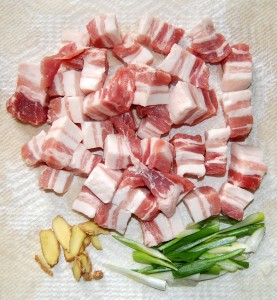
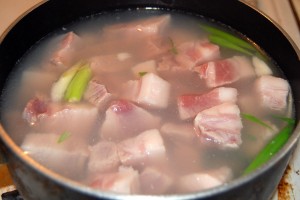
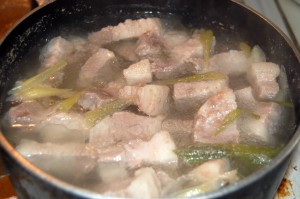
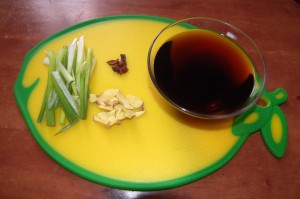
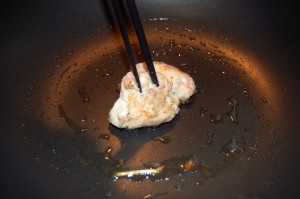
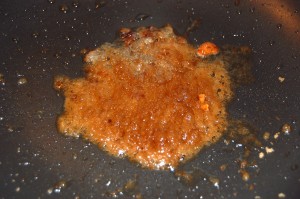
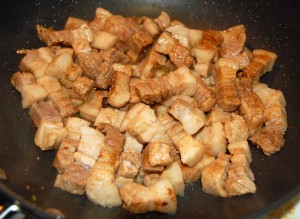
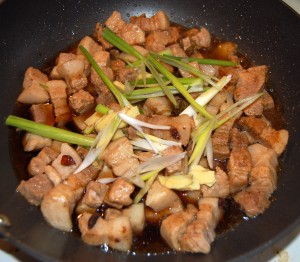
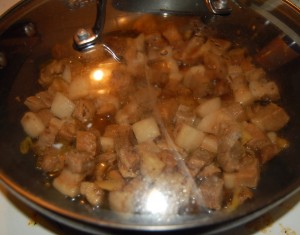

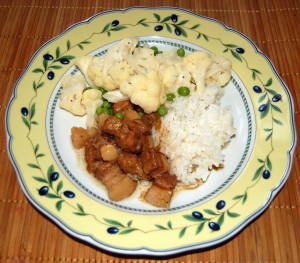




Your recipe looks really delicious.
Does the soy sauce you used contains wheat or did you used a gluten free sauce?
That looks delightful. Do you prefer a traditional steel wok, or a nonstick wok? I have an old, well seasoned steel wok that I haven’t used in years. Might be time to dig it out of the closet.
Hi Daniel,
This particular soy sauce does have wheat. Hopefully the long fermentation detoxifies it somewhat. We should probably search out some gluten-free brands.
Hi Lacey,
We are using non-stick woks. That may not be optimal but it is certainly convenient.
Best, Paul
Try San-J Organic Tamari Sauce (The Gluten Free version!). We buy it at Whole Foods. It is the best soy sauce I have ever tasted.
OK, you’re going to start receiving some of my grocery bills. This recipe, like the others that you post, looks SO good. Plus, just watched an episode of Top Chef which got me in the mood to try pork belly. I will probably go with fresh pork belly vice any canned options 😉
“…since zero-calorie sweeteners trigger insulin release. ”
Now, I agree that over-use of srt. sweeteners is bad, but the insuline repsonse is controverial at the least. Check that out:
http://www.marksdailyapple.com/artificial-sweeteners-insulin/
That said, I use Sucralose with caution (my whey does contain it and I have ~1.5 portions/day). If rice-syrup is pure glucose, how about glucose powder? I use it with berries to better the fructose:glucose ratio – and to make it sweeter.
That said, I like your recipe! Sounds really tasty.
I’m a pork-lover anyways!
“it seems the body evolved to expect sweet tastes to be followed by an infusion of sugar, since zero-calorie sweeteners trigger insulin release.”
do you know if this is the case with Stevia Paul? I came across these few studies but I’m not too good at reading this stuff so I’m a bit confused by it all
http://www.ncbi.nlm.nih.gov/pubmed/10690946
http://www.ncbi.nlm.nih.gov/pubmed/19106249
http://www.ncbi.nlm.nih.gov/pubmed/14681845
Also, do you know if rice syrup contains some of the undesirables from the brown rice it’s made from(phytic acid, lectins etc) Even though sugar no longer features heavily in my diet there are a few odd times here and there where I need some kind of sweetener to use in cooking. Aside from stevia, which I now might have doubts about, there doesn’t seem to be a sweetener out there which isn’t either full of fructose or qualifies as some kind of frankenstein concoction I don’t want to touch. You’ve got my hopes up with rice syrup!
Hi Doug,
Stevia does trigger insulin release, as your 3rd link shows.
However, this is not necessarily harmful.
I support use of Stevia and sugar alcohols, this is why they are listed on our “Recommended Supplements” page. I think they are healthy – I just wanted to make the point that glucose is also healthy in moderation, it is a nutrient, and so caloric sweeteners like rice syrup are also healthy.
Brown rice does contain some toxins and so white rice syrup may be better. Our “Recommended Supplements” page has a white rice syrup from Amazon: http://perfecthealthdiet.com/?page_id=1066. But I don’t think brown rice toxins are that big a deal. They’re not immunogenic so they won’t cause severe disease. If you’re well nourished the phytate isn’t a big deal.
So, the sweeteners we recommend are “safe starch” syrups; stevia and sugar alcohol non-caloric sweeteners; and, lastly and leastly, processed glucose sweeteners made from unsafe starches – but only if safe starch sources are unavailable, and these are to be avoided by anyone who is gluten sensitive.
ahh I didn’t realize there was a white rice syrup, nor did I see the list of sweeteners on your recommended supplements page.Excellent! Thankyou!
Paul,
I have a question about dietary AGEs if you don’t mind.
Are you sure that AGEs can be absorbed in the gut? I can’t seem to find much information on particle size. Perhaps people with healthy guts should not worry and those with high gut permeability should?
It seems that cooking foods almost always yields more positives than negatives since it makes nutrients more available and destroys some anti-nutrients and plant toxins. I’m also guessing the ability to cook played a significant role in human evolution because it allowed us access to higher amounts of starch calories to fill up glycogen stores and feed a glucose-hungry brain. Theoretically this could have allowed for our brains to grow to such a large size since less energy is needed for digestion of cooked foods/starches (the human gut is proportionally smaller: Kleiber’s Law). Well, consuming coked foods/starches and maybe also eating other animal brains rich in DHA once we figured out how to crack skulls open… I’m getting slightly off topic!
I’ve read several animal (rat, I believe) studies on AGEs. It seems that the more AGEs the animal consumes, the shorter its lifespan (microwaved foods were by FAR the worst for the little guys). There is also the ‘classic’ example of Pottenger’s Cats. But do these animal studies really shed any light on the idea that humans, the ONLY animals who evolved eating cooked foods, should attempt to avoid AGE’s also?
I do not deny that consuming significant quantities of oxidized fats (rancid oils) and oxidized cholesterol are dangerous (and possibly denatured milk proteins). Maybe consuming some of those bad guys and some AGEs are the trade-off to obtaining more nutrients when consuming cooked foods? Is this just another cost-benefit situation?
Recommending that someone minimize their use of microwaves and barbecues sounds like pseudoscience, but I just can’t seem to find enough evidence either way to make up my mind.
What do you think?
Thank you (really!).
Hi Katie,
I think that a well-functioning gut with a good mucosal and intestinal barrier (tight junctions) should import very few AGEs … but that people with damaged guts may import significant amounts of dietary AGEs, or else the dietary AGEs may further damage the gut due to local toxic effects.
There is an association with dietary AGEs and ill health in diseases like diabetes: e.g. http://www.ncbi.nlm.nih.gov/pubmed/20229096. Diseases people often have poor guts. The mechanisms by which dietary AGEs cause damage aren’t known, but the association seems to warrant caution.
There’s also the possibility in those animal studies that AGEs are only correlates of other changes that cause trouble. In Pottenger’s Cats, taurine deficiency is the main problem with cooking, so higher AGE content of cooked food is a marker but not the cause of trouble.
If you’re healthy I wouldn’t worry too much about dietary AGEs, thus we are willing to caramelize sugar once in a while, but I think in general it’s good to cook at low temperatures and avoid mixing sugar and meat.
If you have gut problems then maybe avoiding AGEs is more important.
I would be a lot more concerned about barbecues than about microwaves. Don’t use sugary barbecue sauces and then overcook the meat!
Best, Paul
PS: Shou-Ching says that sugar can be added with the other ingredients, without pre-caramelizing in the oil. I don’t know if that reduces AGE content or not.
Congratulations on this terrific recipe. During supper, I found it difficult to stop eating, so much that there wasn’t all that much left for the college student who was at class when supper was served.
The slab of pork belly (pork side) that I purchased had a thick rind, which I sliced and pulled away. Tedious activity. Opportunity to meditate.
I substituted sweet onion for the scallions (don’t like the latter), and wheat-free tamari for the soy sauce. Added the star anise, which to my taste is a key addition. The sauce may benefit from fresh garlic. When I read the recipe, I thought it would require black pepper, but during tasting I realized that pepper would overwhelm the other flavors.
Which side vegetables to serve still puzzles me.
In conclusion, great recipe, thanks for sharing.
Hi R.K. – I’m glad you tried it! It is a luxurious dish.